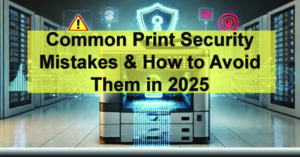Common Print Security Mistakes & How to Avoid Them in 2025
When you think about cybersecurity, your mind probably jumps to firewalls, antivirus software, or encrypted cloud platforms. But let’s be honest — how often do you think about the security of your printers and copiers?
If you’re like most business leaders, the answer is probably “not enough.” And you wouldn’t be alone. In 2025, as digital threats continue to evolve, your printers, copiers, and multifunction devices (MFPs) remain one of the most commonly overlooked vulnerabilities in your entire IT infrastructure.
Let’s want to walk you through some of the most common print security mistakes we’ve seen companies make — and more importantly, how you can avoid them. Whether you’re running a law firm in Denver, a medical office in Colorado Springs, or a construction company in Fort Collins, the risks are real — and the solutions are well within reach.
Let’s make sure your print environment is as secure as the rest of your network.
Why You Can’t Afford to Ignore Print Security
Here’s the thing: your printers and copiers are no longer simple, standalone devices. Today’s office equipment is smarter than ever — connected to your network, storing data, emailing scanned documents, and in many cases, accessible remotely.
That means they’re vulnerable. And if you’re not actively securing these devices, you’re potentially giving hackers a backdoor into your business. It’s not just about safeguarding your data — it’s also about protecting your reputation, your compliance status, and your bottom line.
Let’s take a look at where things often go wrong and how you can take control.
Mistake #1: Leaving Sensitive Documents in the Output Tray
What’s the risk?
It happens more often than you think — someone prints payroll data, client contracts, or medical records, then forgets to pick it up. Anyone passing by can grab it. In industries like healthcare or finance, this could mean a serious compliance violation.
How you can fix it:
Use secure print release features. These require you or your employees to authenticate at the device before documents are printed — using a badge, code, or PIN. Not only does this protect confidentiality, but it also cuts down on wasted paper from forgotten print jobs.
If your current equipment doesn’t support this, it’s worth considering an upgrade. Brands like Canon, HP, and Kyocera have excellent built-in security features for secure print release.
Mistake #2: Skipping Firmware and Software Updates
What’s the risk?
Your printers run on software (firmware), just like your computers. And if you’re not updating them regularly, you’re leaving the door open for attackers to exploit known vulnerabilities.
How you can fix it:
Make it a habit — or better yet, build it into your IT protocols — to check for and install firmware updates. Many newer devices allow you to schedule updates or handle them remotely. If you’re working with a Managed Print Services (MPS) provider, make sure they’re handling this for you.
Mistake #3: Using Default Passwords (or None at All)
What’s the risk?
Many printers come out of the box with generic admin usernames and passwords like “admin” or “1234.” If you’ve never changed them, your devices could be accessible to anyone with an internet connection and a little determination.
How you can fix it:
As soon as a new device is installed, update the administrator credentials with strong, unique passwords. If your equipment supports it, enable multi-factor authentication for additional protection. And don’t forget to periodically review access logs to see who’s logging into the device.
Mistake #4: Not Securing the Network Connection
What’s the risk?
If your printers are connected to the internet — or even to your Wi-Fi — without proper encryption, you’re essentially broadcasting an invitation to anyone looking to exploit a weak entry point.
How you can fix it:
You want to make sure every device is behind your firewall and connected to a secured internal network. Disable unused ports and protocols (like FTP or Telnet), and use encrypted connections (HTTPS, SSL/TLS) for the web interface.
If you’re unsure how your printers are currently configured, this is an area where a quick assessment from your IT team or provider can go a long way.
Mistake #5: Ignoring Activity Logs and Device Reports
What’s the risk?
Your printers keep logs — but if you’re not reviewing them, you won’t see the red flags. Large print jobs during off-hours? Unauthorized users printing sensitive documents? You’ll miss all of it.
How you can fix it:
Enable logging and auditing on all devices. You can often access this data directly from the admin interface or your print management software. Look for unusual patterns and review them monthly at a minimum.
If you’re working with an MPS provider, confirm that they monitor activity and provide alerts for anomalies.
Mistake #6: Letting Everyone Access Everything
What’s the risk?
Not all employees need to access all devices — especially if you’re working in healthcare, law, or finance. Without user-based access controls, you have no visibility or control over who’s printing what.
How you can fix it:
Configure role-based access controls. Limit scan, copy, fax, and print capabilities based on department or user credentials. Most enterprise-grade devices support Active Directory integration to make this process smooth and secure.
Mistake #7: Improperly Disposing of Devices
What’s the risk?
Did you know that many printers store data on internal hard drives — including images of scanned, copied, and printed documents? If you return a leased printer or dispose of an old one without wiping its memory, you could be giving away years of sensitive information.
How you can fix it:
Before decommissioning or returning any device, make sure you (or your provider) perform a full data wipe. Many devices have built-in utilities for this, but you can also request certified data destruction services through your vendor or MPS provider.
How Managed IT Services Strengthen Print Security
If this all sounds like a lot to manage — don’t worry. You don’t have to go it alone.
By partnering with a Managed IT Services provider, you can hand off the heavy lifting and gain confidence knowing that your entire network — including your printers — is being actively monitored and protected.
At ABT, we take a holistic approach to security. Our team doesn’t just look at your servers or laptops — we secure every endpoint, including copiers, printers, and multifunction devices. From automated firmware updates to user-based access controls and encrypted print traffic, we make sure your print environment isn’t the weak link in your cybersecurity chain.
We work with businesses across Colorado and understand the local regulatory landscape. Whether you’re navigating HIPAA compliance in Boulder or PCI-DSS requirements in Denver, we tailor our solutions to fit your needs — and scale with you as you grow.
Your Action Plan for 2025
Let’s make this actionable. Here are your next steps:
-
Implement secure print release to prevent documents from being left unattended.
-
Schedule firmware and software updates for every print device.
-
Change all default credentials and enforce strong passwords.
-
Secure your network connections with proper encryption and firewall settings.
-
Audit your print logs regularly for suspicious activity.
-
Limit device access by role or department.
-
Wipe internal storage before disposing of or returning printers.
You Don’t Have to Do It Alone
Print security isn’t just a “nice-to-have” in 2025 — it’s a must. But it doesn’t have to be overwhelming.
If you’re ready to secure your print environment — or just want a second opinion on how you’re doing — we’re here to help. At ABT, we specialize in helping Colorado businesses like yours take control of their technology and reduce risk at every touchpoint.
Let’s talk. We’ll walk you through a print security assessment, help you identify gaps, and put a plan in place that fits your budget and your business goals.


